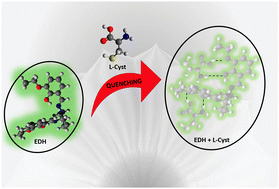A novel Salen-based dual channel sensor for easy and selective nanomolar detection of l-cysteine†
Abstract
Rapid detection of diseases depends on the development of sensors that can readily bind to the analyte of interest in a cost effective and facile manner. In this work, a Salen-type Schiff base colorimetric as well as fluorimetric sensor for L-cysteine is synthesized through a facile methodology, with its structure comprehensively characterized via single-crystal XRD measurements (SCXRD). The purity of the sensor is one of its key aspects, which is unequivocally established here by the crystal data. This probe effectively demonstrates its aptitude for selective recognition of biologically significant molecule, L-cysteine, employing a synergistic combination of static and dynamic fluorescence quenching mechanisms. Employing spectroscopic analyses and density functional theory (DFT) investigations, it has been conclusively ascertained that the nonradiative energy transfer from donor to acceptor occurs not via PET, but rather through a FRET mechanism. The probe exhibits excellent detection stability with a response time under 2 minutes, complemented by a remarkably low detection limit of 1.52 × 10−9 M. The benchmarking studies highlight the proposed sensor's purity (achieved through single crystal isolation), superior nanomolar detection limit, and ease of preparation, making it a strong candidate for upscaling and commercial applications.



 Please wait while we load your content...
Please wait while we load your content...